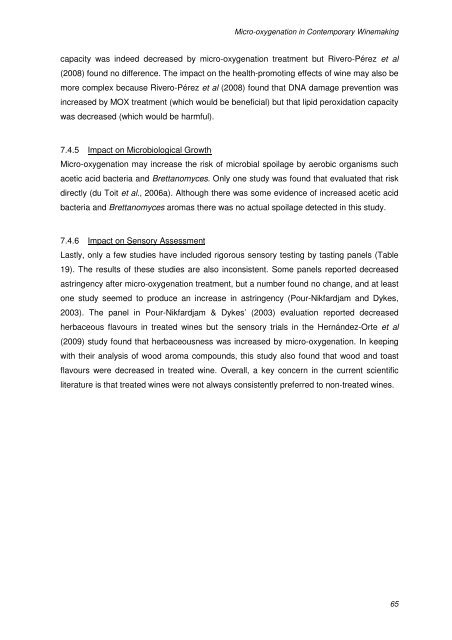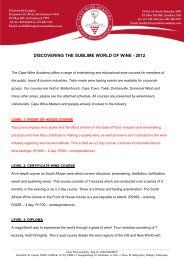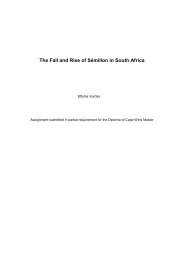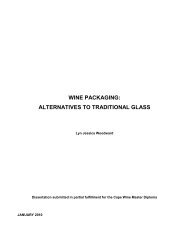micro-oxygenation in contemporary winemaking - Cape Wine ...
micro-oxygenation in contemporary winemaking - Cape Wine ...
micro-oxygenation in contemporary winemaking - Cape Wine ...
You also want an ePaper? Increase the reach of your titles
YUMPU automatically turns print PDFs into web optimized ePapers that Google loves.
Micro-<strong>oxygenation</strong> <strong>in</strong> Contemporary W<strong>in</strong>emak<strong>in</strong>gcapacity was <strong>in</strong>deed decreased by <strong>micro</strong>-<strong>oxygenation</strong> treatment but Rivero-Pérez et al(2008) found no difference. The impact on the health-promot<strong>in</strong>g effects of w<strong>in</strong>e may also bemore complex because Rivero-Pérez et al (2008) found that DNA damage prevention was<strong>in</strong>creased by MOX treatment (which would be beneficial) but that lipid peroxidation capacitywas decreased (which would be harmful).7.4.5 Impact on Microbiological GrowthMicro-<strong>oxygenation</strong> may <strong>in</strong>crease the risk of <strong>micro</strong>bial spoilage by aerobic organisms suchacetic acid bacteria and Brettanomyces. Only one study was found that evaluated that riskdirectly (du Toit et al., 2006a). Although there was some evidence of <strong>in</strong>creased acetic acidbacteria and Brettanomyces aromas there was no actual spoilage detected <strong>in</strong> this study.7.4.6 Impact on Sensory AssessmentLastly, only a few studies have <strong>in</strong>cluded rigorous sensory test<strong>in</strong>g by tast<strong>in</strong>g panels (Table19). The results of these studies are also <strong>in</strong>consistent. Some panels reported decreasedastr<strong>in</strong>gency after <strong>micro</strong>-<strong>oxygenation</strong> treatment, but a number found no change, and at leastone study seemed to produce an <strong>in</strong>crease <strong>in</strong> astr<strong>in</strong>gency (Pour-Nikfardjam and Dykes,2003). The panel <strong>in</strong> Pour-Nikfardjam & Dykes’ (2003) evaluation reported decreasedherbaceous flavours <strong>in</strong> treated w<strong>in</strong>es but the sensory trials <strong>in</strong> the Hernández-Orte et al(2009) study found that herbaceousness was <strong>in</strong>creased by <strong>micro</strong>-<strong>oxygenation</strong>. In keep<strong>in</strong>gwith their analysis of wood aroma compounds, this study also found that wood and toastflavours were decreased <strong>in</strong> treated w<strong>in</strong>e. Overall, a key concern <strong>in</strong> the current scientificliterature is that treated w<strong>in</strong>es were not always consistently preferred to non-treated w<strong>in</strong>es.65
















